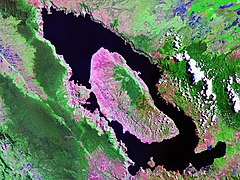Toba catastrophe theory
| Toba catastrophe theory | |
|---|---|

Illustration of what the eruption might have looked like from about 42 kilometres (26 mi) above Pulau Simeulue.
|
|
| Volcano | Toba supervolcano |
| Date | 74,100—75,900 years ago |
| Location |
Sumatra, Indonesia 2°41′04″N 98°52′32″E / 2.6845°N 98.8756°ECoordinates: 2°41′04″N 98°52′32″E / 2.6845°N 98.8756°E |
| VEI | 8 |
| Impact | Second-most recent supereruption; plunged Earth into 6 years of volcanic winter, possibly significant changes to regional topography. |

Lake Toba is the resulting crater lake.
|
|
The Toba supereruption was a supervolcanic eruption that occurred about 75,000 years ago at the site of present-day Lake Toba (Sumatra, Indonesia). It is one of the Earth's largest known eruptions. The Toba catastrophe theory holds that this event caused a global volcanic winter of 6–10 years and possibly a 1,000-year-long cooling episode.
In 1993, science journalist Ann Gibbons suggested a link between the eruption and a population bottleneck in human evolution, and Michael R. Rampino of New York University and Stephen Self of the University of Hawaii at Manoa gave support to the idea. In 1998, the bottleneck theory was further developed by Stanley H. Ambrose of the University of Illinois at Urbana-Champaign. Both the link and global winter theories are highly controversial.
The Toba event is the most closely studied supereruption.
The Toba eruption or Toba event occurred at the present location of Lake Toba, in Indonesia, about 75000±900 years Before Present (BP) according to potassium argon dating. This eruption was the last and largest of four eruptions of Toba during the Quaternary period, and is also recognized from its diagnostic horizon of ashfall, the youngest Toba tuff (YTT). It had an estimated volcanic explosivity index of 8 (the maximum rating attained by any known eruption on Earth); it made a sizable contribution to the 100×30 km caldera complex.Dense-rock equivalent (DRE) estimates of eruptive volume for the eruption vary between 2000 km3 and 3000 km3 – the most common DRE estimate is 2800 km3 (about 7×1015 kg) of erupted magma, of which 800 km3 was deposited as ash fall.
...
Wikipedia
